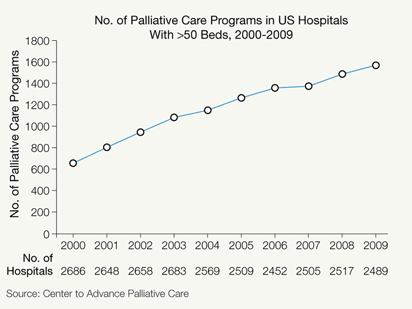Last week found papers on palliative care and discussing prognosis and goals of care with the elderly in JAMA and NEJM. The paper in JAMA documents the rise in hospital based palliative care services, 2000-09.
 This demonstrates one way in which access to palliative care (care that addresses symptoms, patient goals and quality of life, regardless of prognosis) is expanding, and slowly the conception of palliative care is understood to be more than just hospice (team based palliative care that focuses on persons believed to be in the last 6 months of their life). All hospice is palliative care, but all palliative care is not hospice. Key issues relate to how such care will be financed, and the general assumption is that such units are now cross subsidized by other, more lucrative services in many hospitals. How to provide community based palliative care is even more difficult.
This demonstrates one way in which access to palliative care (care that addresses symptoms, patient goals and quality of life, regardless of prognosis) is expanding, and slowly the conception of palliative care is understood to be more than just hospice (team based palliative care that focuses on persons believed to be in the last 6 months of their life). All hospice is palliative care, but all palliative care is not hospice. Key issues relate to how such care will be financed, and the general assumption is that such units are now cross subsidized by other, more lucrative services in many hospitals. How to provide community based palliative care is even more difficult.
Also last week, there was a NEJM perspective article by Alex Smith and others (his blog GeriPal) focusing on the issue of discussing longevity with the very old who don’t have any particular ailment that can be identified as likely to kill them any time soon. This issue of important on many levels: everything from how to make medical decisions to how to make financial decisions, all informed by a reasonable understanding of life expectancy (not only the average, but the bounds). The following scenario motivates the piece:
It’s late in the day in the office of a busy primary care physician, who is relieved to see that his last patient is a woman who, though 86 years old, has multiple stable medical problems and is visiting for her annual exam. The patient is accompanied by her daughter, who helps her mother with several activities of daily living, including bathing, dressing, and balancing her checkbook. During the visit, the daughter asks about preventive health measures for her mother: “It’s been years since her last colonoscopy, hasn’t it?” The physician explains that national guidelines recommend against cancer screening for patients over 85 years of age.1 The patient responds, “What do you mean, doctor? From what I see on TV, cancer is a disease of the elderly.”
This is not a palliative care scenario, but a primary care one. However, some of the key palliative care ideas of helping patients clarify goals of care, and making treatment decisions with full information are needed throughout the health care system. Having papers like these two in JAMA and the NEJM in the same week is a step in that direction.
DT

